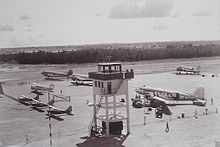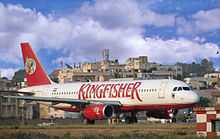HAL Bangalore Airport
| HAL Bangalore Airport ಹಾಲ್ ಬೆಂಗಳೂರು ವಿಮಾನ ನಿಲ್ದಾಣ HAL Airport | |||||||||||
|---|---|---|---|---|---|---|---|---|---|---|---|
| IATA: none – ICAO: VOBG | |||||||||||
| Summary | |||||||||||
| Airport type | Military | ||||||||||
| Operator |
| ||||||||||
| Location | Bangalore | ||||||||||
| Elevation AMSL | 2,912 ft / 888 m | ||||||||||
| Coordinates | 12°57′0″N 77°40′6″E / 12.95000°N 77.66833°ECoordinates: 12°57′0″N 77°40′6″E / 12.95000°N 77.66833°E | ||||||||||
| Website | http://aai.aero | ||||||||||
| Map | |||||||||||
 HAL Bangalore Airport | |||||||||||
| Runways | |||||||||||
| |||||||||||
HAL Bangalore Airport (ICAO: VOBG), also known as HAL Airport or Hindustan Airport, is an airport used as a business hub for general aviation, a testing facility by Hindustan Aeronautics Limited and the Indian Armed Forces. It served as the city's domestic and international airport until 2008, and was replaced by the Bengaluru International Airport on 24 May 2008. Since the airport is located at the heart of the city, it is the preferred destination for general and business aviation.
Overview

In 1964, the airport was acquired by the Indian Government and was mainly used for defence purposes. Domestic commercial flights started in the 1980s and international destinations in 1997. The airport had gone through a series of expansions and upgrades to keep pace with the growing civilian air traffic in the city. While the rated capacity of the airport was 3.6 million passengers per year it was last operating at a super saturated level of 7.5 million. Reportedly HAL requested airlines to discontinue the addition of flights to and from Bangalore some time ago.
Transfer of civilian operations
The airport is the primary site of HAL's research and development operations, currently half of the Indian Air Force fleet consists of aircraft manufactured by the company. The airport's management issue also caused contention between the Ministry of Defence and the Ministry of Civil Aviation. Thus turf wars may have been the major problem, and not over-riding operational factors.
In 2005, Bangalore International Airport Limited, started construction on the new airport. HAL airport's civilian operations were replaced by Bengaluru International Airport, while the old airport serves non scheduled operations and as a test and research facility.
Land side structure

There were separate check-in sections for domestic and international departures and arrivals. The airport has two aerobridges.
Air side structure
HAL Airport has one runway, oriented to 90/270 degrees. There are 4 entry/exit taxiways, 2 on the east side called E2 (perimeter) and E1. Similarly there are 2 taxiways to the west side - W2 (perimeter) and W1.
There are now 6 aprons, apron 1 through apron 6. Apron 1 is the main apron, and has 10 parking bays. Bay 5 and bay 6 correspond to the 2 aerobridges. Airport has got more than 30 bays.
ATC frequencies in use
The frequencies normally in use at VOBG are:
| Call Sign | Used for | Frequency | |
|---|---|---|---|
| 1 | Bangalore Tower | Runway to 5,000 ft (1,500 m) | 123.5 MHz |
| 2 | Bangalore Radar | 5,000 ft (1,500 m) to 46,000 ft (14,000 m) | 127.7 MHz |
| 3 | Bangalore Radar (not used during off-peak hours) | Used as an intermediate step between the tower (123.5) and radar (127.7) | 120.6 MHz |
| 4 | Bangalore Ground (not used during off-peak hours) | Ground movement - off runway | 121.95 MHz |
| 5 | Bangalore ATIS | Information | 128.25 MHz |
Most aircraft move to Chennai air traffic control (ATC) airspace immediately before or after Bangalore. Chennai ATC is operated on 119.5 MHz.
Incidents and accidents
- 14 February 1990, Indian Airlines Flight 605, an Airbus A320, crashed on final approach with 92 fatalities.[1]
- 28 December 1996, a Blue Dart Aviation Boeing 737 made a heavy, off-center landing causing damage to the aircraft and runway.[2]
- 12 February 2004, a helicopter being used by the HAL Rotary Wing Academy crashes, injuring both occupants.[3]
- 26 October 2005, an Indian Air Force MiG-21 crashes killing the pilot.[4]
- 11 March 2006, a Deccan ATR 72, with 40 passengers and 4 crew makes a heavy landing. There are no major injuries but the aircraft is written off.[5][6]
- 4 May 2006, a Transmile Air Services 727-2F2F suffered damage to the left wing fuel tank.[7]
- 21 August 2006, a Kiran Mark II trainer aircraft crashes after the wheels failed.[8]
- 6 June 2007, Sri Lankan Cargo Antonov An-12 loses engine power on runway.[9]
- 6 March 2009, A NAL Saras aircraft prototype that had taken off from HAL Bangalore crashed in a field near Bidadi, killing the three man crew of test pilots.[10]
References
- ↑ Flight 605 at the Aviation Safety Network
- ↑ Incident report at the Aviation Safety Network
- ↑ Chopper crash-lands at HAL Airport
- ↑ Pilot killed as MiG crashes in Bangalore
- ↑ Incident report at the Aviation Safety Network
- ↑ Air Deccan aircraft skids off runway
- ↑ Incident report at the Aviation Safety Network
- ↑ Plane crash-lands at Bangalore Airport
- ↑ Air traffic disrupted as cargo aircraft gets stuck on runway
- ↑
External links
| Wikimedia Commons has media related to HAL Bangalore International Airport. |
- Airport information for VOBG at World Aero Data. Data current as of October 2006.
- Accident history for BLR at Aviation Safety Network
| ||||||||||||||||||||||||||||||||||||||||||||||||||||||||||||||||||||||||||||||||||||||||||||||||||||||||||||||||||||||||||||||||||||||||||||||||||||||||||||||||||||||||||||||||||||||||||||||||||||||||||||||||||||||||||||||||||||||||||||||||||||||||||||||||||||||||||||||||||||||||||||||